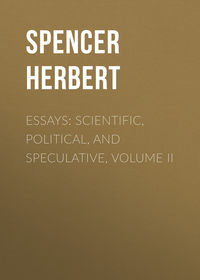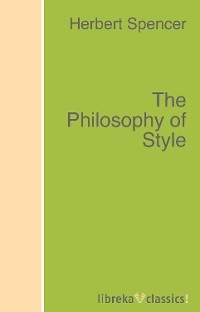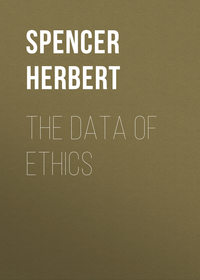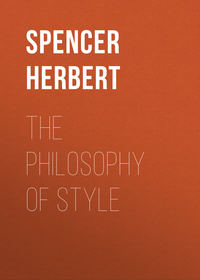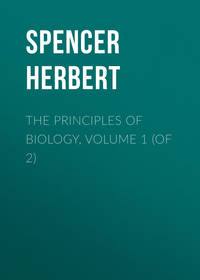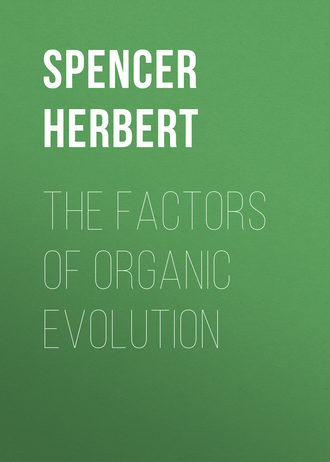 полная версия
полная версияThe Factors of Organic Evolution
Fully to perceive the way in which these evidences compel us to recognize the influence of the medium as a primordial factor, we need but conceive them as interpreted without it. Suppose, for instance, we say that the structure of the epidermis is wholly determined by the natural selection of favourable variations; what must be the position taken in presence of the fact above named, that when mucous membrane is exposed to the air its cell-structure changes into the cell-structure of skin? The position taken must be this: – Though mucous membrane in a highly-evolved individual organism, thus shows the powerful effect of the medium on its surface; yet we must not suppose that the medium had the effect of producing such a cell-structure on the surfaces of primitive forms, undifferentiated though they were; or, if we suppose that such an effect was produced on them, we must not suppose that it was inheritable. Contrariwise, we must suppose that such effect of the medium either was not wrought at all, or that it was evanescent: though repeated through millions upon millions of generations it left no traces. And we must conclude that this skin-structure arose only in consequence of spontaneous variations not physically initiated (though like those physically initiated) which natural selection laid hold of and increased. Does any one think this a tenable position?
And now we approach the last and chief series of morphological phenomena which must be ascribed to the direct action of environing matters and forces. These are presented to us when we study the early stages in the development of the embryos of the Metazoa in general.
We will set out with the fact already noted in passing, that after repeated spontaneous fissions have changed the original fertilized germ-cell into that cluster of cells which forms a gemmule or a primitive ovum, the first contrast which arises is between the peripheral parts and the central parts. Where, as with lower creatures which do not lay up large stores of nutriment with the germs of their offspring, the inner mass is inconsiderable, the outer layer of cells, which are presently made quite small by repeated subdivisions, forms a membrane extending over the whole surface – the blastoderm. The next stage of development, which ends in this covering layer becoming double, is reached in two ways – by invagination and by delamination; but which is the original way and which the abridged way, is not quite certain. Of invagination, multitudinously exemplified in the lowest types, Mr. Balfour says: – “On purely à priori grounds there is in my opinion more to be said for invagination than for any other view”;17 and, for present purposes, it will suffice if we limit ourselves to this: making its nature clear to the general reader by a simple illustration.
Take a small india-rubber ball – not of the inflated kind, nor of the solid kind, but of the kind about an inch or so in diameter with a small hole through which, under pressure, the air escapes. Suppose that instead of consisting of india-rubber its wall consists of small cells made polyhedral in form by mutual pressure, and united together. This will represent the blastoderm. Now with the finger, thrust in one side of the ball until it touches the other: so making a cup. This action will stand for the process of invagination. Imagine that by continuance of it, the hemispherical cup becomes very much deepened and the opening narrowed, until the cup becomes a sac, of which the introverted wall is everywhere in contact with the outer wall. This will represent the two-layered “gastrula” – the simplest ancestral form of the Metazoa: a form which is permanently represented in some of the lowest types; for it needs but tentacles round the mouth of the sac, to produce a common hydra. Here the fact which it chiefly concerns us to remark, is that of these two layers the outer, called in embryological language the epiblast, continues to carry on direct converse with the forces and matters in the environment; while the inner, called the hypoblast, comes in contact with such only of these matters as are put into the food-cavity which it lines. We have further to note that in the embryos of Metazoa at all advanced in organization, there arises between these two layers a third – the mesoblast. The origin of this is seen in types where the developmental process is not obscured by the presence of a large food-yolk. While the above-described introversion is taking place, and before the inner surfaces of the resulting epiblast and hypoblast have come into contact, cells, or amœboid units equivalent to them, are budded off from one or both of these inner surfaces, or some part of one or other; and these form a layer which eventually lies between the other two – a layer which, as this mode of formation implies, never has any converse with the surrounding medium and its contents, or with the nutritive bodies taken in from it. The striking facts to which this description is a necessary introduction, may now be stated. From the outer layer, or epiblast, are developed the permanent epidermis and its out-growths, the nervous system, and the organs of sense. From the introverted layer, or hypoblast, are developed the alimentary canal and those parts of its appended organs, liver, pancreas, &c., which are concerned in delivering their secretions into the alimentary canal, as well as the linings of those ramifying tubes in the lungs which convey air to the places where gaseous exchange is effected. And from the mesoblast originate the bones, the muscles, the heart and blood-vessels, and the lymphatics, together with such parts of various internal organs as are most remotely concerned with the outer world. Minor qualifications being admitted, there remain the broad general facts, that out of that part of the external layer which remains permanently external, are developed all the structures which carry on intercourse with the medium and its contents, active and passive; out of the introverted part of this external layer, are developed the structures which carry on intercourse with the quasi-external substances that are taken into the interior – solid food, water, and air; while out of the mesoblast are developed structures which have never had, from first to last, any intercourse with the environment. Let us contemplate these general facts.
Who would have imagined that the nervous system is a modified portion of the primitive epidermis? In the absence of proofs furnished by the concurrent testimony of embryologists during the last thirty or forty years, who would have believed that the brain arises from an unfolded tract of the outer skin, which, sinking down beneath the surface, becomes imbedded in other tissues and eventually surrounded by a bony case? Yet the human nervous system in common with the nervous systems of lower animals is thus originated. In the words of Mr. Balfour, early embryological changes imply that —
“the functions of the central nervous system, which were originally taken by the whole skin, became gradually concentrated in a special part of the skin which was step by step removed from the surface, and has finally become in the higher types a well-defined organ imbedded in the subdermal tissues… The embryological evidence shows that the ganglion-cells of the central part of the nervous system are originally derived from the simple undifferentiated epithelial cells of the surface of the body.”18
Less startling perhaps, though still startling enough, is the fact that the eye is evolved out of a portion of the skin; and that while the crystalline lens and its surroundings thus originate, the “percipient portions of the organs of special sense, especially of optic organs, are often formed from the same part of the primitive epidermis” which forms the central nervous system.19 Similarly is it with the organs for smelling and hearing. These, too, begin as sacs formed by in-foldings of the epidermis; and while their parts are developing they are joined from within by nervous structures which were themselves epidermic in origin. How are we to interpret these strange transformations? Observing, as we pass, how absurd from the point of view of the special-creationist, would appear such a filiation of structures, and such a round-about mode of embryonic development, we have here to remark that the process is not one to have been anticipated as a result of natural selection. After numbers of spontaneous variations had occurred, as the hypothesis implies, in useless ways, the variation which primarily initiated a nervous centre might reasonably have been expected to occur in some internal part where it would be fitly located. Its initiation in a dangerous place and subsequent migration to a safe place, would be incomprehensible. Not so if we bear in mind the cardinal truth above set forth, that the structures for holding converse with the medium and its contents, arise in that completely superficial part which is directly affected by the medium and its contents; and if we draw the inference that the external actions themselves initiate the structures. These once commenced, and furthered by natural selection where favourable to life, would form the first term of a series ending in developed sense organs and a developed nervous system.20
Though it would enforce the argument, I must, for brevity's sake, pass over the analogous evolution of that introverted layer, or hypoblast, out of which the alimentary canal and attached organs arise. It will suffice to emphasize the fact that having been originally external, this layer continues in its developed form to have a quasi-externality, alike in its digesting part and in its respiratory part; since it continues to deal with matters alien to the organism. I must also refrain from dwelling at length on the fact already adverted to, that the intermediate derived layer, or mesoblast, which was at the outset completely internal, originates those structures which ever remain completely internal, and have no communication with the environment save through the structures developed from the other two: an antithesis which has great significance.
Here, instead of dwelling on these details, it will be better to draw attention to the most general aspect of the facts. Whatever may be the course of subsequent changes, the first change is the formation of a superficial layer or blastoderm; and by whatever series of transformations the adult structure is reached, it is from the blastoderm that all the organs forming the adult originate. Why this marvellous fact?
Meaning is given to it if we go back to the first stage in which Protozoa, having by repeated fissions formed a cluster, then arranged themselves into a hollow sphere, as do the protophytes forming a Volvox. Originally alike all over its surface, the hollow sphere of ciliated units thus formed, would, if not quite spherical, assume a constant attitude when moving through the water; and hence one part of the spheroid would more frequently than the rest come in contact with nutritive matters to be taken in. A division of labour resulting from such a variation being advantageous, and tending therefore to increase in descendants, would end in a differentiation like that shown in the gemmules of various low types of Metazoa, which, ovate in shape, are ciliated over one part of the surface only. There would arise a form in which the cilium-bearing units effected locomotion and aeration; while on the others, assuming an amœba-like character, devolved the function of absorbing food: a primordial specialization variously indicated by evidence.21 Just noting that an ancestral origin of this kind is implied by the fact that in low types of Metazoa a hollow sphere of cells is the form first assumed by the unfolding embryo, I draw attention to the point here of chief interest; namely that the primary differentiation of this hollow sphere is in such case determined by a difference in the converse of its parts with the medium and its contents; and that the subsequent invagination arises by a continuance of this differential converse.
Even neglecting this first stage and commencing with the next, in which a “gastrula” has been produced by the permanent introversion of one portion of the surface of the hollow sphere, it will suffice if we consider what must thereafter have happened. That which continued to be the outer surface was the part which from time to time touched quiescent masses and occasionally received the collisions consequent on its own motions or the motions of other things. It was the part to receive the sound-vibrations occasionally propagated through the water; the part to be affected more strongly than any other by those variations in the amounts of light caused by the passing of small bodies close to it; and the part which met those diffused molecules constituting odours. That is to say, from the beginning the surface was the part on which there fell the various influences pervading the environment, the part by which there was received those impressions from the environment serving for the guidance of actions, and the part which had to bear the mechanical re-actions consequent upon such actions. Necessarily, therefore, the surface was the part in which were initiated the various instrumentalities for carrying on intercourse with the environment. To suppose otherwise is to suppose that such instrumentalities arose internally where they could neither be operated on by surrounding agencies nor operate on them, – where the differentiating forces did not come into play, and the differentiated structures had nothing to do; and it is to suppose that meanwhile the parts directly exposed to the differentiating forces remained unchanged. Clearly, then, organization could not but begin on the surface; and having thus begun, its subsequent course could not but be determined by its superficial origin. And hence these remarkable facts showing us that individual evolution is accomplished by successive in-foldings and in-growings. Doubtless natural selection soon came into action, as, for example, in the removal of the rudimentary nervous centres from the surface; since an individual in which they were a little more deeply seated would be less likely to be incapacitated by injury of them. And so in multitudinous other ways. But nevertheless, as we here see, natural selection could operate only under subjection. It could do no more than take advantage of those structural changes which the medium and its contents initiated.
See, then, how large has been the part played by this primordial factor. Had it done no more than give to Protozoa and Protophyta that cell-form which characterizes them – had it done no more than entail the cellular composition which is so remarkable a trait of Metazoa and Metaphyta– had it done no more than cause the repetition in all visible animals and plants of that primary differentiation of outer from inner which it first wrought in animals and plants invisible to the naked eye; it would have done much towards giving to organisms of all kinds certain leading traits. But it has done more than this. By causing the first differentiations of those clusters of units out of which visible animals in general arose, it fixed the starting place for organization, and therefore determined the course of organization; and, doing this, gave indelible traits to embryonic transformations and to adult structures.
Though mainly carried on after the inductive method, the argument at the close of the foregoing section has passed into the deductive. Here let us follow for a space the deductive method pure and simple. Doubtless in biology à priori reasoning is dangerous; but there can be no danger in considering whether its results coincide with those reached by reasoning à posteriori.
Biologists in general agree that in the present state of the world, no such thing happens as the rise of a living creature out of non-living matter. They do not deny, however, that at a remote period in the past, when the temperature of the Earth's surface was much higher than at present, and other physical conditions were unlike those we know, inorganic matter, through successive complications, gave origin to organic matter. So many substances once supposed to belong exclusively to living bodies, have now been formed artificially, that men of science scarcely question the conclusion that there are conditions under which, by yet another step of composition, quaternary compounds of lower types pass into those of highest types. That there once took place gradual divergence of the organic from the inorganic, is, indeed, a necessary implication of the hypothesis of Evolution, taken as a whole; and if we accept it as a whole, we must put to ourselves the question – What were the early stages of progress which followed, after the most complex form of matter had arisen out of forms of matter a degree less complex?
At first, protoplasm could have had no proclivities to one or other arrangement of parts; unless, indeed, a purely mechanical proclivity towards a spherical form when suspended in a liquid. At the outset it must have been passive. In respect of its passivity, primitive organic matter must have been like inorganic matter. No such thing as spontaneous variation could have occurred in it; for variation implies some habitual course of change from which it is a divergence, and is therefore excluded where there is no habitual course of change. In the absence of that cyclical series of metamorphoses which even the simplest living thing now shows us, as a result of its inherited constitution, there could be no point d'appui for natural selection. How, then, did organic evolution begin?
If a primitive mass of organic matter was like a mass of inorganic matter in respect of its passivity, and differed only in respect of its greater changeableness; then we must infer that its first changes conformed to the same general law as do the changes of an inorganic mass. The instability of the homogeneous is a universal principle. In all cases the homogeneous tends to pass into the heterogeneous, and the less heterogeneous into the more heterogeneous. In the primordial units of protoplasm, then, the step with which evolution commenced must have been the passage from a state of complete likeness throughout the mass to a state in which there existed some unlikeness. Further, the cause of this step in one of these portions of organic matter, as in any portion of inorganic matter, must have been the different exposure of its parts to incident forces. What incident forces? Those of its medium or environment. Which were the parts thus differently exposed? Necessarily the outside and the inside. Inevitably, then, alike in the organic aggregate and the inorganic aggregate (supposing it to have coherence enough to maintain constant relative positions among its parts), the first fall from homogeneity to heterogeneity must always have been the differentiation of the external surface from the internal contents. No matter whether the modification was physical or chemical, one of composition or of decomposition, it comes within the same generalization. The direct action of the medium was the primordial factor of organic evolution.
And now, finally, let us look at the factors in their ensemble, and consider the respective parts they play: observing, especially, the ways in which, at successive stages, they severally give place one to another in degree of importance.
Acting alone, the primordial factor must have initiated the primary differentiation in all units of protoplasm alike. I say alike, but I must forthwith qualify the word. For since surrounding influences, physical and chemical, could not be absolutely the same in all places, especially when the first rudiments of living things had spread over a considerable area, there necessarily arose small contrasts between the degrees and kinds of superficial differentiation effected. As soon as these became decided, natural selection came into play; for inevitably the unlikenesses produced among the units had effects on their lives: there was survival of some among the modified forms rather than others. Utterly in the dark though we are respecting the causes which set up that process of fission everywhere occurring among the minutest forms of life, we must infer that, when established, it furthered the spread of those which were most favourably differentiated by the medium. Though natural selection must have become increasingly active when once it had got a start; yet the differentiating action of the medium never ceased to be a co-operator in the development of these first animals and plants. Again taking the lead as there arose the composite forms of animals and plants, and again losing the lead with that advancing differentiation of these higher types which gave more scope to natural selection, it nevertheless continued, and must ever continue, to be a cause, both direct and indirect, of modifications in structure.
Along with that remarkable process which, beginning in minute forms with what is called conjugation, developed into sexual generation, there came into play causes of frequent and marked fortuitous variations. The mixtures of constitutional proclivities made more or less unlike by unlikenesses of physical conditions, inevitably led to occasional concurrences of forces producing deviations of structure. These were of course mostly suppressed, but sometimes increased, by survival of the fittest. When, along with the growing multiplication in forms of life, conflict and competition became continually more active, fortuitous variations of structure of no account in the converse with the medium, became of much account in the struggle with enemies and competitors; and natural selection of such variations became the predominant factor. Especially throughout the plant-world its action appears to have been immensely the most important; and throughout that large part of the animal world characterized by relative inactivity, the survival of individuals that had varied in favourable ways, must all along have been the chief cause of the divergence of species and the occasional production of higher ones.
But gradually with that increase of activity which we see on ascending to successively higher grades of animals, and especially with that increased complexity of life which we also see, there came more and more into play as a factor, the inheritance of those modifications of structure caused by modifications of function. Eventually, among creatures of high organization, this factor became an important one; and I think there is reason to conclude that, in the case of the highest of creatures, civilized men, among whom the kinds of variation which affect survival are too multitudinous to permit easy selection of any one, and among whom survival of the fittest is greatly interfered with, it has become the chief factor: such aid as survival of the fittest gives, being usually limited to the preservation of those in whom the totality of the faculties has been most favourably moulded by functional changes.
Of course this sketch of the relations among the factors must be taken as in large measure a speculation. We are now too far removed from the beginnings of life to obtain data for anything more than tentative conclusions respecting its earliest stages; especially in the absence of any clue to the mode in which multiplication, first agamogenetic and then gamogenetic, was initiated. But it has seemed to me not amiss to present this general conception, by way of showing how the deductive interpretation harmonizes with the several inferences reached by induction.
In his article on Evolution in the Encyclopædia Britannica, Professor Huxley writes as follows: —
“How far 'natural selection' suffices for the production of species remains to be seen. Few can doubt that, if not the whole cause, it is a very important factor in that operation… On the evidence of palaeontology, the evolution of many existing forms of animal life from their predecessors is no longer an hypothesis, but an historical fact; it is only the nature of the physiological factors to which that evolution is due which is still open to discussion.”
With these passages I may fitly join a remark made in the admirable address Prof. Huxley delivered before unveiling the statue of Mr. Darwin in the Museum at South Kensington. Deprecating the supposition that an authoritative sanction was given by the ceremony to the current ideas concerning organic evolution, he said that “science commits suicide when it adopts a creed.”


